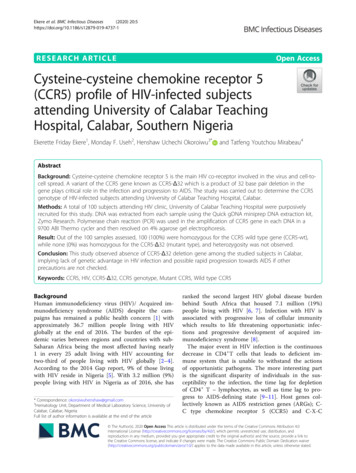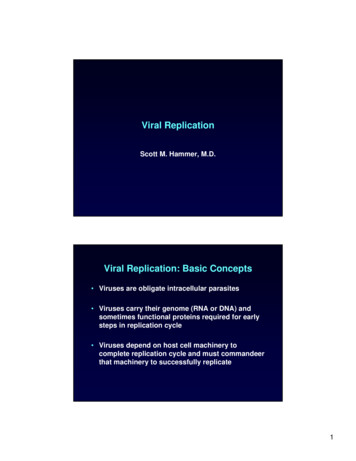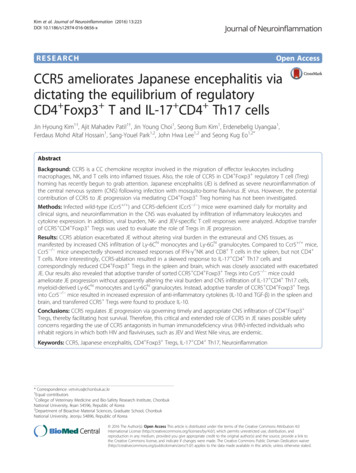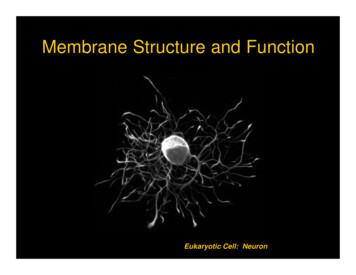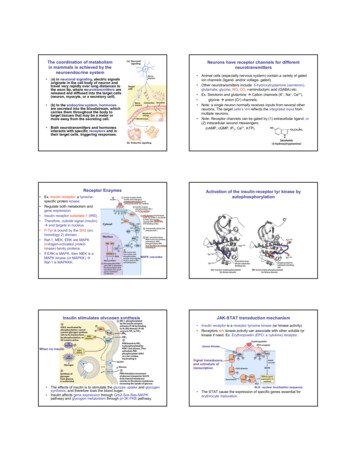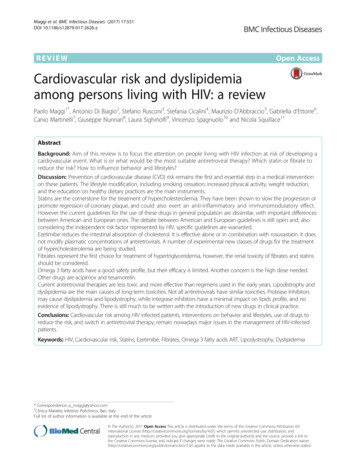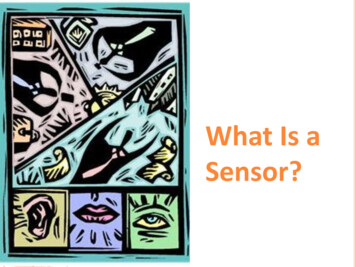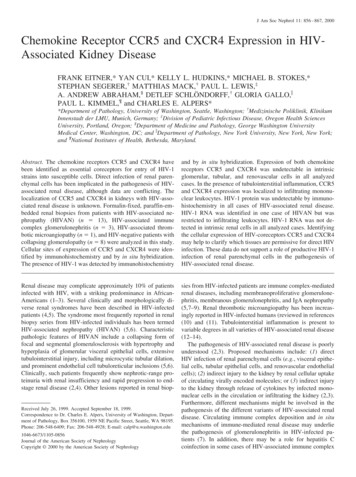
Transcription
J Am Soc Nephrol 11: 856 – 867, 2000Chemokine Receptor CCR5 and CXCR4 Expression in HIVAssociated Kidney DiseaseFRANK EITNER,* YAN CUI,* KELLY L. HUDKINS,* MICHAEL B. STOKES,*STEPHAN SEGERER,† MATTHIAS MACK,† PAUL L. LEWIS,‡A. ANDREW ABRAHAM,§ DETLEF SCHLÖNDORFF,† GLORIA GALLO,储PAUL L. KIMMEL,¶ and CHARLES E. ALPERS**Department of Pathology, University of Washington, Seattle, Washington; †Medizinische Poliklinik, KlinikumInnenstadt der LMU, Munich, Germany; ‡Division of Pediatric Infectious Disease, Oregon Health SciencesUniversity, Portland, Oregon; §Department of Medicine and Pathology, George Washington UniversityMedical Center, Washington, DC; and 储Department of Pathology, New York University, New York, New York;and ¶National Institutes of Health, Bethesda, Maryland.Abstract. The chemokine receptors CCR5 and CXCR4 havebeen identified as essential coreceptors for entry of HIV-1strains into susceptible cells. Direct infection of renal parenchymal cells has been implicated in the pathogenesis of HIVassociated renal disease, although data are conflicting. Thelocalization of CCR5 and CXCR4 in kidneys with HIV-associated renal disease is unknown. Formalin-fixed, paraffin-embedded renal biopsies from patients with HIV-associated nephropathy (HIVAN) (n 13), HIV-associated immunecomplex glomerulonephritis (n 3), HIV-associated thrombotic microangiopathy (n 1), and HIV-negative patients withcollapsing glomerulopathy (n 8) were analyzed in this study.Cellular sites of expression of CCR5 and CXCR4 were identified by immunohistochemistry and by in situ hybridization.The presence of HIV-1 was detected by immunohistochemistryand by in situ hybridization. Expression of both chemokinereceptors CCR5 and CXCR4 was undetectable in intrinsicglomerular, tubular, and renovascular cells in all analyzedcases. In the presence of tubulointerstitial inflammation, CCR5and CXCR4 expression was localized to infiltrating mononuclear leukocytes. HIV-1 protein was undetectable by immunohistochemistry in all cases of HIV-associated renal disease.HIV-1 RNA was identified in one case of HIVAN but wasrestricted to infiltrating leukocytes. HIV-1 RNA was not detected in intrinsic renal cells in all analyzed cases. Identifyingthe cellular expression of HIV-coreceptors CCR5 and CXCR4may help to clarify which tissues are permissive for direct HIVinfection. These data do not support a role of productive HIV-1infection of renal parenchymal cells in the pathogenesis ofHIV-associated renal disease.Renal disease may complicate approximately 10% of patientsinfected with HIV, with a striking predominance in AfricanAmericans (1–3). Several clinically and morphologically diverse renal syndromes have been described in HIV-infectedpatients (4,5). The syndrome most frequently reported in renalbiopsy series from HIV-infected individuals has been termedHIV-associated nephropathy (HIVAN) (5,6). Characteristicpathologic features of HIVAN include a collapsing form offocal and segmental glomerulosclerosis with hypertrophy andhyperplasia of glomerular visceral epithelial cells, extensivetubulointerstitial injury, including microcystic tubular dilation,and prominent endothelial cell tubuloreticular inclusions (5,6).Clinically, such patients frequently show nephrotic-range proteinuria with renal insufficiency and rapid progression to endstage renal disease (2,4). Other lesions reported in renal biop-sies from HIV-infected patients are immune complex-mediatedrenal diseases, including membranoproliferative glomerulonephritis, membranous glomerulonephritis, and IgA nephropathy(5,7–9). Renal thrombotic microangiopathy has been increasingly reported in HIV-infected humans (reviewed in references(10) and (11). Tubulointerstitial inflammation is present tovariable degrees in all varieties of HIV-associated renal disease(12–14).The pathogenesis of HIV-associated renal disease is poorlyunderstood (2,3). Proposed mechanisms include: (1) directHIV infection of renal parenchymal cells (e.g., visceral epithelial cells, tubular epithelial cells, and renovascular endothelialcells); (2) indirect injury to the kidney by renal cellular uptakeof circulating virally encoded molecules; or (3) indirect injuryto the kidney through release of cytokines by infected mononuclear cells in the circulation or infiltrating the kidney (2,3).Furthermore, different mechanisms might be involved in thepathogenesis of the different variants of HIV-associated renaldisease. Circulating immune complex deposition and in situmechanisms of immune-mediated renal disease may underliethe pathogenesis of glomerulonephritis in HIV-infected patients (7). In addition, there may be a role for hepatitis Ccoinfection in some cases of HIV-associated immune complexReceived July 26, 1999. Accepted September 18, 1999.Correspondence to Dr. Charles E. Alpers, University of Washington, Department of Pathology, Box 356100, 1959 NE Pacific Street, Seattle, WA 98195.Phone: 206-548-6409; Fax: 206-548-4928; E-mail: calp@u.washington.edu1046-6673/1105-0856Journal of the American Society of NephrologyCopyright 2000 by the American Society of Nephrology
J Am Soc Nephrol 11: 856 – 867, 2000glomerulonephritis (8). Some renal disease in HIV-infectedindividuals, however, may represent chance occurrence unrelated to HIV infection itself.New directions in AIDS research of viral entry, tropism, andpathogenesis were initiated by the recent discovery that members of the chemokine receptor family act as necessary coreceptors together with CD4 for entry of HIV-1 into susceptiblecells (15). HIV-1 strains previously characterized as T lymphocyte-tropic have been shown to bind to the chemokinereceptor CXCR4 as a condition of entry into mammalian cells,while macrophage-tropic strains of HIV-1 require the chemokine receptor CCR5. Expression of these molecules appears toplay a key role in determining which tissues are permissive fordirect HIV infection.Expression of the HIV coreceptors CCR5 and CXCR4 inhuman kidneys with features of HIV-associated renal disease iscompletely unknown. In previous studies from our laboratories, expression of both chemokine receptors CCR5 andCXCR4 was not identified by either immunohistochemical(16) or in situ hybridization (17,18) techniques in intrinsicrenal parenchymal cells in normal human kidneys, in renalallograft nephrectomies, and in human renal biopsies with avariety of different glomerular and interstitial diseases. However, in vitro studies show that the expression of certain chemokine receptors in mononuclear cells is regulated by a number of stimuli (reviewed in references (19) and (20). Anupregulation of CCR5 or CXCR4 expression in intrinsic renalcells might therefore require specific cytokine stimulationpresent in the course of HIV infection.In this study, we tested the hypothesis that the relevantchemokine coreceptors for HIV infection not constitutivelyexpressed in normal kidney may be upregulated in the settingof HIV infection and thereby permit infection of renal tissue.We assessed the cellular sites of expression of chemokinereceptor CCR5 by immunohistochemistry and in situ hybridization, and CXCR4 by in situ hybridization, in renal biopsiesobtained from HIV-infected patients with features of HIVAN,HIV-associated immune complex glomerulonephritis, andHIV-associated thrombotic microangiopathy. Additional tissues examined within this study consisted of human renalbiopsy material with features of a collapsing glomerulopathyfrom patients without clinical evidence of HIV infection. Furthermore, we provide corresponding data for the presence ofHIV-1 protein by immunohistochemistry and for the presenceof HIV-1 RNA by in situ hybridization in each of these cases.Materials and MethodsSource of TissueFormalin-fixed, paraffin-embedded renal biopsy tissue specimensobtained between 1984 and 1998 at the George Washington University Medical Center (Washington, DC), the New York University(New York, NY), and the University of Washington (Seattle, WA)were included in this study. Several cases had been included inprevious studies investigating HIV-associated renal disease(7,8,14,21–23). All renal biopsy cases with sufficient tissue for complete immunohistochemical and in situ hybridization evaluation aftercompletion of diagnostic workup and previous investigations wereChemokine Receptors in HIV-Associated Renal Disease857included. Renal biopsies from 13 patients with HIVAN were studied.All cases demonstrated variable degrees of a collapsing form of focaland segmental glomerulosclerosis with microcystic tubular dilation.Additionally, renal biopsies from three patients with HIV-associatedimmune complex glomerulonephritis were analyzed, including twocases of diffuse proliferative glomerulonephritis and one case ofmembranous nephropathy. One renal biopsy with HIV-associatedrenal thrombotic microangiopathy was also examined. For HIV-negative disease controls, we analyzed kidney samples from eight patientswith collapsing glomerulopathy and negative HIV serology. Tissuesections contained 1 to 20 glomeruli (mean, 4 glomeruli) from patientswith HIVAN and 2, 4, and 10 glomeruli, respectively, from patientswith HIV-associated glomerulonephritis, and 13 glomeruli from thepatient with HIV-associated thrombotic microangiopathy. Kidneysamples from HIV-negative patients with collapsing glomerulopathyincluded 2 to 12 glomeruli (mean, 5 glomeruli). The demography ofthe patient populations in New York and Washington, DC has beenpublished previously (21,24).Formalin-fixed, paraffin-embedded HIV-1-infected human peripheral blood mononuclear cell (PBMC) pellets were generated as controls for immunohistochemical detection of HIV-1 p24 antigen and forin situ hybridization of HIV-1 RNA. Human PBMC were obtainedfrom HIV antibody-negative volunteer donors as described previously(25). Briefly, the PBMC layer was removed after centrifugation ofwhole blood, washed, and resuspended in RPMI 1640 containing 16%fetal calf serum, penicillin (100 U/ml), streptomycin (100 g/ml), andglutamine (0.3 mg/ml). The mononuclear cells were stimulated withphytohemagglutinin (5 g/ml) and 5% nonrecombinant human interleukin-2 (Pharmacia, Piscataway, NJ) as described (25). Forty-eighthours after stimulation, the human PBMC were infected with a cellfree solution of HIV-1 strain LAI. A full-length clone of HIV-1LAI[pBRU3] was obtained from Dr. Michael Emerman, Fred HutchinsonCancer Research Center, Seattle, WA (26). Cell-free stock solutionsof HIV-1LAI were generated by transfection of this plasmid into 293Tcells.) Cells were harvested 48 h after infection and counted in ahemocytometer. Several different preparations were generated bymixing defined concentrations of HIV-1-infected PBMC with definedconcentrations of uninfected PBMC. The different HIV-1-infected/uninfected PBMC preparations contained HIV-1-infected PBMC inconcentrations ranging from 5 to 50%. These mixed PBMC sampleswere subsequently centrifuged, and the remaining cell pellet was fixedin 10% phosphate-buffered formalin and embedded in paraffin usingstandard protocols for tissue preparation. Four-micrometer-thick sections were generated as controls for immunohistochemical and in situhybridization procedures.AntibodiesCCR5. A murine monoclonal antibody MC5 directed againsthuman chemokine receptor CCR5 has previously been characterizedfor specificity by Western blotting and fluorescence-activated cellsorter analysis (16), and was found suitable for the specific detectionof CCR5 in formalin-fixed, paraffin-embedded tissue sections afterheat-mediated antigen retrieval procedures (16).HIV-1. A murine monoclonal antibody p24, clone Kal-1, directed against an epitope of the core protein p24 of HIV-1 waspurchased from DAKO (Carpinteria, CA). Specificity of this antibodyfor the detection of HIV-1 p24 has been demonstrated previously byimmunoprecipitation, Western blotting, and immunohistochemistry(27), and it has been demonstrated previously to recognize HIV-1 p24in formalin-fixed, paraffin-embedded tissue sections (27,28).
858Journal of the American Society of NephrologyJ Am Soc Nephrol 11: 856 – 867, 2000ImmunohistochemistryIn Situ HybridizationImmunohistochemistry was performed on formalin-fixed, paraffinembedded tissue sections according to protocols that we have usedpreviously (29). Four-micrometer sections of tissue samples weredeparaffinized in xylene and rehydrated in graded ethanols. Endogenous peroxidase was blocked by incubation in 3% hydrogen peroxide.Sections that were subsequently incubated with the anti-CCR5 antibody were pretreated by steam heating for 20 min in Antigen Unmasking Solution (Vector Laboratories, Burlingame, CA), accordingto the instructions of the manufacturer. Nonspecific binding wasblocked by incubation in 10% normal horse serum (Vector). Thesections were then incubated for 1 h at room temperature with theprimary antibody diluted in phosphate-buffered saline plus 1% bovineserum albumin (Sigma, St. Louis, MO). After washes in phosphatebuffered saline, the sections were incubated with biotinylated horseanti-mouse antibody (Vector). A Tyramide Signal Amplification(TSA -Indirect, NEN Life Science Products, Boston, MA) wasperformed according to the manufacturer’s instructions. Finally, 3,3 diaminobenzidine (with nickel chloride enhancement) was used as achromogen. Sections were counterstained with methyl green, dehydrated, and coverslipped. The complete biopsies were examined, andthe number of CCR5 protein-expressing cells per glomerular crosssection was calculated in each case. Negative controls for the immunohistochemical procedures consisted of substitution of the primaryantibody with isotype-matched, irrelevant murine monoclonal antibodies (DAKO).HIV-1 RNA, CCR5 mRNA, and CXCR4 mRNA were detected intissue sections using in situ hybridization techniques according toprotocols used previously (29). Riboprobes for in situ hybridizationwere generated from cDNA using 35S-UTP. Four-micrometer sectionsof formalin-fixed, paraffin-embedded tissue samples were deparaffinized and rehydrated through xylene and graded ethanols, washedwith 0.5 SSC (Life Technologies, Grand Island, NY), and digestedwith proteinase K (5 g/ml; Sigma). Sections that were subsequentlyhybridized with HIV-1-specific riboprobes were analyzed in duplicate.In one section, the in situ hybridization was performed according tothe following protocol. The second section was additionally pretreatedby steam heating for 20 min in Antigen Unmasking Solution (Vector)before the hybridization, according to the manufacturer’s instructions.Prehybridization was performed for 2 h by adding 100 l of prehybridization buffer (0.3 M NaCl, 20 mM Tris, pH 8.0, 5 mM ethylenediaminetetra-acetic acid, 1 Denhardt’s solution, 10% dextransulfate, and 10 mM dithiothreitol). The hybridizations were started byadding 500,000 cpm of 35S-labeled riboprobe in 50 l of prehybridization buffer and allowed to proceed overnight at 50 C. After hybridization, sections were treated with RNase A (20 g/ml; Sigma),followed by three high-stringency washes in 0.1 SSC/0.5% Tween20 (Sigma) for 40 min each at 50 C, and several 2 SSC washes.After the tissue was dehydrated and air-dried, it was dipped in NTB2nuclear emulsion (Kodak, Rochester, NY) and exposed in the dark at4 C for 2 wk (HIV-1) or 6 wk (CCR5, CXCR4), respectively. Afterdeveloping, the sections were counterstained with hematoxylin andeosin, dehydrated, and coverslipped. Positive cellular labeling wasdefined as five or more silver grains concentrated over a single cell onthe slides hybridized with the antisense probe, and little or no signalpresent on the sense control slides. The complete biopsies wereexamined, and the numbers of CCR5 mRNA and CXCR4 mRNAexpressing cells per glomerular cross-section were calculated in eachcase. Positive controls for the detection of CCR5 and CXCR4 mRNAconsisted of several allograft nephrectomy specimens with features ofsevere rejection, as published previously (17,18).Molecular ProbesCCR5. A 1.1-kb sequence of DNA coding for human CCR5 wassubcloned into pcDNAI/amp (Invitrogen, San Diego, CA) (obtainedthrough the AIDS Research and Reference Reagent Program, Divisionof AIDS, NIAID, and NIH, originally provided by Dr. NathanielLandau) and then linearized with HindIII and transcribed with Sp6 forthe antisense probe or linearized with SphI and transcribed with T7 forthe sense probe. Sensitivity and specificity of the CCR5 antisenseriboprobe has been demonstrated previously by Northern analysis andby in situ hybridization (17).CXCR4. A 1.1-kb sequence of DNA coding for human CXCR4was subcloned into pcDNAI/amp (Invitrogen) (obtained through theAIDS Research and Reference Reagent Program, Division of AIDS,NIAID, and NIH, originally provided by Dr. Nathaniel Landau) andthen linearized with HindIII and transcribed with Sp6 for the antisenseprobe or linearized with XbaI and transcribed with T7 for the senseprobe. Sensitivity and specificity of the CXCR4 antisense riboprobehave been demonstrated previously by Northern analysis and by insitu hybridization (18).HIV-1. Four DNA templates that collectively represent 90% ofthe HIV-1 genome were purchased from Lofstrand Labs (Gaithersburg, MD): gag, SacI-BglII, 1.4 kb; gag/pol, BglII-EcoRI, 2.6 kb;pol/vif/vpr/rev/tat/vpu, KpnI-KpnI, 2.2 kb; env/vpr/rev/tat/vpu, EcoRIBamHI, 2.7 kb. Antisense and sense riboprobes were generated fromall templates using Sp6 or T7 according to the manufacturer’s instructions. Radioactivity was introduced by synthesis of RNA using 35SUTP. The generated probes were combined to yield one sense orantisense probe cocktail. Specific detection of HIV-1 RNA in formalin-fixed, paraffin-embedded tissue sections by in situ hybridizationwith an estimated sensitivity of 30 to 300 copies of target RNA hasbeen described previously by numerous groups using identical RNAprobes (30 –35).ResultsCCR5 Expression in HIV-Associated Renal DiseaseBy both immunohistochemistry and in situ hybridization,CCR5 expression was absent in intrinsic glomerular cells in allcases of HIVAN, HIV-associated glomerulonephritis, HIVassociated thrombotic microangiopathy, and HIV-negative collapsing glomerulopathy. Parietal epithelial cells, visceral epithelial cells, mesangial cells, and glomerular endothelial cellsin glomeruli, with and without features of collapse, did notexpress detectable CCR5 (Figure 1, A through D). A fewCCR5-positive cells were detected in the capillary lumina ofsome glomeruli in cases of all different groups (Figure 1, A andB, Table 1). These cells likely represented circulating mononuclear leukocytes.All cases of the different disease groups analyzed in thisstudy showed variable degrees of tubulointerstitial inflammation ranging from very mild, focal, perivascular infiltrates ofleukocytes to severe, diffuse interstitial mononuclear cell infiltrates. CCR5-expressing cells were demonstrable by bothimmunohistochemistry (Figure 1, E and F) and in situ hybridization (Figure 1, G and H) in these infiltrates in the tubulo-
J Am Soc Nephrol 11: 856 – 867, 2000Chemokine Receptors in HIV-Associated Renal Disease859Figure 1. Chemokine receptor CCR5 expression in HIV-associated nephropathy (HIVAN). (A and B) Low and high magnification illustration ofCCR5 immunohistochemistry. Several CCR5 protein-expressing leukocytes (black) were demonstrable at sites of periglomerular leukocyticinfiltration. A single CCR5 protein-expressing circulating mononuclear leukocyte (arrow) is demonstrable within a glomerular capillary lumen. CCR5protein expression was absent in intrinsic glomerular cells. (C) No CCR5 mRNA expression was seen in intrinsic glomerular cells by in situhybridization. (D) High-power view of Panel C shows CCR5 mRNA (black silver grains) restricted to mononuclear cells within a periglomerularinflammatory cell infiltrate (arrow). (E) In the tubulointerstitial compartment, CCR5 protein-expressing infiltrating mononuclear cells (black) weredemonstrable by immunohistochemistry at sites of leukocytic infiltration. The area around CCR5-expressing cells in Panel E (arrow) is illustrated athigher magnification in Panel F. CCR5 protein expression was absent in tubular epithelium. (G) In situ hybridization for CCR5 mRNA matched theresults of the CCR5 immunohistochemistry. The area around CCR5 mRNA-expressing cells in Panel G (arrow) is illustrated at higher magnificationin Panel H. Numerous CCR5 mRNA-expressing leukocytes (black silver grains) were detectable at a site of tubulointerstitial infiltration; no specifichybridization signal for CCR5 mRNA was present in tubular epithelial cells. Methyl green counterstain in A, B, E, and F; hematoxylin and eosincounterstain in C, D, G, and H. Magnification: 400 in A, C, E, and G; 1000 in B, D, F and H.
860Journal of the American Society of NephrologyJ Am Soc Nephrol 11: 856 – 867, 2000Table 1. Chemokine receptor-expressing cells within glomeruliaCategoryCXCR4 mRNA-PositiveCells/GlomeruliCCR5 Protein-PositiveCells/GlomeruliCCR5 mRNA-PositiveCells/GlomeruliHIV-associated nephropathy (n 13)HIV-associated immune complexglomerulonephritis (n 3)HIV-associated thromboticmicroangiopathy (n 1)Collapsing glomerulopathy, HIVnegative (n 8)0.4 0.61.4 1.70.3 0.30.3 0.30.1 0.10.2 0.44.01.10.10.6 0.40.3 0.30.1 0.3aData are given as mean values SD of chemokine receptor-expressing cells per glomerular cross-sections.interstitial compartment of all analyzed cases. The expressionof CCR5 was restricted to infiltrating mononuclear cells (Figure 1, E through H). The number of CCR5-expressing cellscorrelated with the degree of tubulointerstitial mononuclearcell infiltration. No difference in the CCR5 expression patternon infiltrating leukocytes was seen between patients with HIVassociated renal disease or HIV-negative disease controls (datanot shown). Tubular epithelial cells, whether located in areaswith absence of interstitial inflammation, at sites of severetubulointerstitial mononuclear cell infiltration, or at sites ofmicrocystic tubular dilation, showed no detectable CCR5 expression (Figure 1, E through H). CCR5 expression was completely absent in endothelial cells and smooth muscle cells ofthe vascular compartment.The number of leukocytes exhibiting expression of theCCR5 protein as detected by immunohistochemistry correlatedwith the number of leukocytes synthesizing detectable CCR5mRNA in all individual cases (Figure 1, compare Panels F andH). However, in the glomerular compartment slightly moreCCR5-positive leukocytes were identified by immunohistochemistry compared with in situ hybridization (Table 1).CXCR4 Expression in HIV-Associated Renal DiseaseBy in situ hybridization, CXCR4 mRNA expression remained undetectable in cells clearly identifiable as renal parenchymal cells of the glomerular, tubular, and vascular compartments in all analyzed cases. At sites of collapsingglomeruli, CXCR4 mRNA expression was typically absent(Figure 2, A and B). However, within all analyzed cases smallnumbers of individual CXCR4 mRNA-expressing cells wereidentified within glomeruli (Figure 2, C and D) (Table 1). Wewere unable to clearly determine whether these CXCR4mRNA-expressing cells were intrinsic glomerular cells or circulating leukocytes, although we favor the latter interpretation.All of the biopsy tissue was consumed during the course of thepresent studies, and so material was unavailable for doublelabeling studies that might confirm this interpretation.Within the tubulointerstitial compartment, CXCR4 mRNAexpression was restricted to infiltrating mononuclear leukocytes at sites of tubulointerstitial inflammation (Figure 2, E andF). There was no difference in the number of detectableCXCR4 mRNA-expressing leukocytes between HIV-1-positive or -negative renal tissues. CXCR4 mRNA expression wasundetectable in tubular epithelial cells, including those at sitesof tubulointerstitial inflammation and at sites of microcystictubular dilation (Figure 2, E and F). Renovascular endothelialcells did not show detectable CXCR4 mRNA expression.Comparison of CCR5 and CXCR4 expression in serial sections of the analyzed specimens revealed that both chemokinereceptors were expressed in a large percentage of interstitialinfiltrating mononuclear leukocytes. The number of CCR5- orCXCR4-expressing cells, respectively, correlated positivelywith the degree of tubulointerstitial inflammation. No obviousdifferences in the distribution pattern of CCR5- or CXCR4expressing infiltrating leukocytes were evident. Because of thetechnical limitation of serial sections, we could not properlyaddress the question of whether CCR5 and CXCR4 werecoexpressed in the same subset of infiltrating mononuclearleukocytes, or whether CCR5 and CXCR4 were expressed indifferent leukocyte subsets. As indicated above, exhaustion ofthe biopsy samples precluded double-labeling studies thatwould address this issue.Specificity of the HIV-1 p24 Immunohistochemistry andof the HIV-1 RNA in Situ HybridizationImmunohistochemical detection of HIV-1 proteins in formalin-fixed, paraffin-embedded renal tissue sections has beenvery unreliable and frequently resulted in nonspecific immunostaining in tissue obtained from HIV-negative controls(36,37). We therefore performed a series of experiments tocontrol the specificity of our procedures. As positive controls,formalin-fixed, paraffin-embedded PBMC pellets, containingHIV-1-infected PBMC, reproducibly demonstrated positiveimmunostaining (Figure 3, A through C). Furthermore, thenumber of cells with positive immunohistochemical signalwithin the pellet closely reflected the number of HIV-1-infected PBMC mixed in the pellet preparation (Figure 3, Athrough D). No immunostaining was detectable in HIV-1infected PBMC when the primary antibody was substituted byan irrelevant, isotype-matched mouse IgG preparation (data notshown). PBMC pellets that contained no HIV-1-infected cells
J Am Soc Nephrol 11: 856 – 867, 2000Chemokine Receptors in HIV-Associated Renal Disease861Figure 2. Chemokine receptor CXCR4 expression in HIVAN. (A and B) Low and high magnification illustration of CXCR4 in situhybridization. CXCR4 mRNA expression was absent in a glomerulus with typical features of a collapsing glomerulopathy. Severalmononuclear leukocytes within a periglomerular interstitial infiltrate (arrow) showed detectable CXCR4 mRNA expression (black silvergrains). (C and D) Low and high magnification illustration of CXCR4 in situ hybridization. CXCR4 mRNA expression (black silver grains)was localized to a cluster of three individual cells (arrows) whose precise identity cannot be ascertained by their location or appearance in thesesections, within the illustrated glomerular cross-section. (E and F) Low and high magnification illustration of in situ hybridization for CXCR4mRNA. Within the tubulointerstitial compartment, CXCR4 mRNA expression (black silver grains) was clearly restricted to inflammatoryinterstitial mononuclear leukocytes (arrow), whereas tubular epithelial cells did not demonstrate detectable CXCR4 mRNA expression. CXCR4mRNA expression was absent at sites of microcystic tubular dilation (c). Hematoxylin and eosin counterstain in A through F. Magnification: 400 in A, C, and E; 1000 in B, D, and F.showed no detectable immunostaining with the HIV-1 p24antibody (Figure 3D). Renal biopsy sections from patients withcollapsing glomerulopathy and negative HIV serology (n 8)consistently showed absent immunohistochemical stainingwhen incubated with the HIV-1 p24 antibody (data not shown).PBMC pellets containing HIV-1-infected PBMC consistently showed detectable in situ hybridization signal for HIV-1RNA (Figure 3E). The number of PBMC with positive hybridization signal closely reflected the number of HIV-1-infectedPBMC mixed in the pellet preparation. No difference in thenumber of HIV-1 RNA-positive PBMC was seen in the in situhybridization procedures with and without heat-mediated pretreatment of the PBMC pellet specimens before hybridization(data not shown). No hybridization was seen when identicalprocedures were performed with substitution of a control senseprobe for hybridization (Figure 3F). All renal biopsies obtainedfrom HIV-negative control patients showed absent hybridization signal for HIV-1 RNA (data not shown).
862Journal of the American Society of NephrologyJ Am Soc Nephrol 11: 856 – 867, 2000DiscussionFigure 3. Specificity of the HIV-1 p24 immunohistochemistry (Athrough D) and HIV-1 RNA in situ hybridization (E through F).Formalin-fixed, paraffin-embedded peripheral blood mononuclear cell(PBMC) pellet preparations containing defined concentrations ofHIV-1-infected PBMC were used. (A) Positive immunostaining forHIV-1 p24 (black) was detectable in approximately 50% of the cellsin a section of a formalin-fixed, paraffin-embedded PBMC pelletcontaining 50% HIV-1-infected PBMC. (B) Immunohistochemistryfor HIV-1 p24 labels approximately 33% of the PBMC in a cell pelletcontaining 33% HIV-1-infected PBMC. (C) Approximately 5% of thePBMC are immunohistochemically labeled in a cell pellet containing5% HIV-1-infected PBMC. (D) PBMC pellets that contained noHIV-1-infected cells showed no detectable immunostaining with theHIV-1 p24 antibody. (E) In situ hybridization detects HIV-1 RNA(black silver grains) in numerous HIV-1-infected cells in a section ofa formalin-fixed, paraffin-embedded PBMC pellet containing 33%HIV-1-infected PBMC. (F) No hybridization signal was seen in thesame PBMC pellet as illustrated in Panel E when identical procedureswere performed with substitution of a control sense probe for hybridization. Methyl green counterstain in A through D; hematoxylin andeosin counterstain in E and F. Magnification: 1000.Detection of HIV-1 in Biopsies from Patients with HIVAssociated Renal DiseaseBy immunohistochemistry, HIV-1 p24 protein was not detected in glomerular (Figure 4B), tubulointerstitial (
verse renal syndromes have been described in HIV-infected patients (4,5). The syndrome most frequently reported in renal . St. Louis, MO). After washes in phosphate-buffered saline, the sections were incubated with biotinylated horse anti-mouse antibody (Vector). A Tyramide Signal Amplification (TSA -Indirect, NEN Life Science Products .
